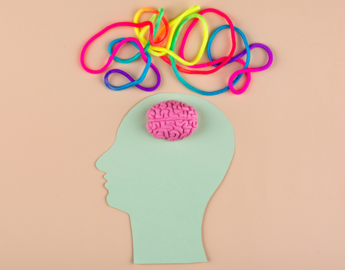What is neurodiversity?
Neurodiversity refers to the natural variation in how we think, learn, process and communicate information. In other words, no two brains are identical; we all think, learn, process and communicate information differently. A majority of people identify as neurotypical (NT) because their way of thinking, learning, processing and communicating information aligns with societal standards of what is considered “normal.”
In contrast, a smaller portion of the population has ways of thinking, learning, processing and communicating that do not conform to these societal standards. These individuals identify as neurodivergent (ND). It is important to understand that neurodivergence is not a medical diagnosis, and anyone can self-identify as neurodivergent. While some neurodivergent individuals have specific diagnoses, such as ADHD, dyslexia or autism spectrum disorder, anyone who experiences differences in how they think, process or engage with the world can self-identify as neurodivergent, even without a formal diagnosis (Walker, 2025).
Furthermore, it is crucial to recognize that differences in thinking, learning, processing or communicating are not deficits; they are simply differences. Like neurotypical individuals, neurodivergent people also possess unique strengths and skills. Recognizing and valuing the strengths of everyone, regardless of whether they identify as neurotypical or neurodivergent, is essential.
Lesson checklist
- Understand the definition of neurodiversity as well as different types of inclusion: emotional, social, cognitive and physical
- Gain strategies for creating positive, welcoming and inclusive learning spaces for neurodivergent students by incorporating UDL principles into the higher education classroom
- Set priorities for emotional, social, physical/sensory and cognitive inclusion in your courses
Creating neuro-inclusive environments is essential for valuing neurodivergent individuals and harnessing their strengths. To achieve this, we must focus on several key aspects:
- Actively work to eliminate biases and stereotypes about neurodivergence
- Provide safe spaces where individuals can disclose their neurodivergent status if they choose to or remove the need to disclose completely by making supports and adjustments freely available
- Design and renovate environments with physical and sensory components in mind to accommodate different needs
- Offer training programs to educate everyone about neurodiversity
- Develop ways for all individuals, regardless of neurotypical or neurodivergent status, to engage and participate fully in the community
Implementing these strategies will help create a holistic sense of belonging for everyone. This concept of holistic belonging comes from Dr. Ludmila Praslova’s book, The Canary Code: A Guide to Neurodiversity, Dignity, and Intersectional Belonging at Work (2024).
The connection between neurodiversity and UDL
Universal Design for Learning (UDL) strives to create an effective learning environment for everyone. Similarly, neuro-inclusive environments take into account the unique experiences of neurodivergent students and provide flexible approaches to learning that can benefit all students. Therefore, UDL and neuro-inclusive learning environments have complementary goals, as both aim to remove barriers and ensure that students can thrive.
UDL principles can create positive, welcoming and inclusive learning spaces for neurodivergent students by incorporating multiple means of engagement, representation, and action and expression. These strategies acknowledge the diversity of how students think and learn, promoting a more equitable and accessible learning experience.
Values statements about neuro-inclusion
- All students deserve the opportunity for higher education. This includes students who think and learn differently, fostering an environment that recognizes and values their unique strengths
- Inclusion respects diverse cognitive approaches and sensory needs. A neuro-inclusive environment promotes acceptance, understanding and respect for the full spectrum of neurodiverse experiences
- Flexibility in teaching and learning. Neuro-inclusive practices embrace flexibility, offering students different ways to participate and demonstrate their knowledge that align with their strengths, as appropriate for the context
- Supporting autonomy and self-advocacy. Neuro-inclusion values student autonomy and encourages the development of self-advocacy skills, empowering students to articulate their needs and access necessary supports


Values statements about UDL
- All students deserve the opportunity for higher education
- Instructors can anticipate learner diversity while planning a course. This proactive approach ensures that course design includes diverse ways of engaging with the content, demonstrating knowledge and accessing resources
- Instructors can proactively incorporate UDL principles to support learner diversity. This reduces the need for reactive accommodations and creates a more seamless learning experience
- UDL can be used to reduce barriers to learning, thereby reducing the need to accommodate individual students. By considering a wide range of learning preferences and needs from the outset, UDL minimizes hurdles that can inhibit student success
- UDL strives to achieve equitable access for all students. It aims to provide multiple pathways to success, ensuring that every student has the opportunity to fully participate in and benefit from the learning experience
Neuro-inclusion and UDL
Praslova (2024) divided the concept of holistic belonging and neuro-inclusion into four areas: emotional inclusion, social inclusion, physical/sensory inclusion and cognitive inclusion.
Emotional inclusion
Emotional inclusion in higher education involves creating environments that promote emotional well-being and encourage students to be their authentic selves as learners. To foster emotional inclusion, instructors should remove biased language and other biases from the classroom and promote inclusivity.
Multiple means of engagement allows students to engage in the learning in different ways, which can increase confidence and motivation.
- Provide student choice where feasible
- Some students may thrive on in-class discussions while others may prefer online discussions
- Offer a choice of topics for an essay or research paper
- Help students to develop self-regulation and motivation for learning
- Provide checklists for students to track their own progress
- Have students do an exam debrief with a partner after exams have been returned. They can discuss questions such as: How do my answers compare with the correct answers? What confusions do I still need to clarify? What course material do I need to review and practise? What exam preparation strategies worked well and what might I do differently next time?
- Use metacognitive techniques in your teaching to model them to students, so that they learn to use them as well. One such strategy is the “think aloud” technique in which you describe a step-by-step process. Describe what you are doing and why, as well as any potential drawbacks
- Another metacognitive technique is diagramming. Present information in graphs, charts, timelines and other representations as appropriate. For topics that are not easily represented in graphical form, create a mind map while describing the connections. As a follow up, ask students to create their own mind map on another topic and discuss it with an elbow partner once they have completed it (Ellis et al., 2014)
When students feel they can access course materials and achieve the learning outcomes, it lessens their stress and helps them to feel supported. A positive learning environment that is mindful of students’ emotional needs benefits neurodivergent students because they do not feel excluded anymore.
- Avoid ableist language in the classroom
- Provide different ways of accessing course content, such as recorded lectures with transcription
- Use different pedagogical approaches such as narratives, logic, case studies or problem solving, to lessen the anxiety some students may feel when adapting to a singular approach
- Incorporate frequent checks for understanding so that neurodivergent students, and indeed all students, can evaluate their progress in a course. By monitoring their progress, students can strengthen their understanding prior to assessment, which enhances emotional well-being
- Add a think-pair-share activity to a lecture using a student response system
- Leave time for a Q&A session at the end of a session
- Use the muddiest point strategy at the end of a lecture. Either hand out a piece of paper or use an electronic note-taking tool for students to let you know what they are still confused about. You can then address misconceptions and points of confusion during the next class and/or put supplementary materials in the learning management system
- Ongoing feedback helps student improve and then feel more confident about their learning
- Add computer-graded practice quizzes to the learning management system so that students can practise and gauge their learning prior to assessment
- Incorporate a short, non-graded quiz into classes and have students grade their own work. Use a think-aloud protocol to explain solutions and build students’ metacognitive skills
- Address assessment anxiety
- Increase assessment literacy by discussing exams and assessments in class. Talk about common strategies for writing different types of questions that are included in your exams
- If you use a rubric for an assignment, make it available at the start of the assignment. Have students discuss the rubric in pairs and jot down any questions they still have about how they will be assessed
Social inclusion
Social inclusion in higher education means ensuring that every student can participate in the learning community. Students may participate in different ways, but they are all included in the learning process. Where possible, instructors provide supports or adjustments to enhance social inclusion for neurodivergent students.
- Varying teaching and learning activities will allow neurodivergent students to identify approaches that work for them
- Incorporate interaction with others, including peer-to-peer interaction and interaction with the teaching team. This will prevent students from feeling isolated in the course. Strategies include:
- in-class and online discussions
- group learning
- problem-based learning
- inquiry-based learning
- study groups
- Student-created materials allow them to contribute to the classroom community and learning
- Students could create a graphic organizer that summarizes a topic or unit
- They could also create concept maps, illustrations, storyboards or metaphors
- Collaborative note taking allows everyone to contribute
- Students could create their own glossary of terms throughout the course
- Incorporate student choice to allow students to demonstrate their knowledge in various ways, if appropriate for the course
- Allow students to choose between an in-class or recorded presentation
- Students might choose between a traditional paper, or creating a website or graphic novel, for example
- Provide opportunities for feedback throughout the course
- Incorporate in-class peer feedback for assignments where students are working on different topics
- Offer regular office hours. If you have teaching assistants, they could provide drop-in office hours as well
- Arrange student-led study groups
- Demonstration of skills: Role play and debates can be either graded or non-graded activities
Physical/sensory inclusion
Physical/sensory inclusion is when the learning space is designed for sensory sensitivities. While many aspects of a learning space are beyond an instructor’s control, there may be ways in which they can influence the environment to be more inclusive.
- Use technology to engage differently within the classroom. For example, Padlet allows participants to draw, write, and use speech or videos to contribute to the conversation
- Some classrooms have harsh lighting, loud acoustics or uncomfortable seating. If feasible, use Zoom or another tool for synchronous in-person and online (hybrid) classes. Hybrid classes require some planning and support to implement, so it might not be practical in some cases However, it would allow learners to connect with the course in an environment that is conducive to their learning
The physical environment can have an impact on student achievement, such as exams. While the instructor may not have any flexibility for adjusting the physical environment for exams, the following points can be considered where there is choice.
- Flexible furniture and equipment
- Provide quiet spaces for taking tests
- Incorporate simulations or demonstration of skills
Cognitive inclusion
Cognitive inclusion refers to several ways in which students are supported in order to achieve the learning outcomes for a course. The instructor might vary the pedagogical approaches in a course, provide supports or offer course content in a variety of modalities. They can incorporate student choice where possible and vary assessments. The following ideas can get you started.
- Vary teaching approaches, such as active lecturing, discussion-based pedagogy, in-class activities or collaborative online activities
- Provide student choice of course content where feasible
- Provide accessible course materials
- Labs: Have lab instructions available in both video (in-depth explanation) and text (quick reference)
- Vary pedagogical approaches, such as logic, statistics, narrative, case study and testimonials
- Check for comprehension and understanding of key concepts by incorporating practice exercises and solutions
- Vary the question types on exams (multiple choice, matching, fill in the blank, written) and vary the types of exams (case study, equations, diagram and labelling)
- Incorporate authentic assessment into your assignments, such as a demonstration of skills
- Incorporate student choice where feasible (in-person or online presentation)
Activity
Some aspects of UDL are relatively quick to incorporate into your course. Others will require a much higher time investment, yet they could have a potentially large benefit for learners. For this activity, use the attached worksheet to think about the UDL strategies you would like to try and put them in a quadrant of the matrix based on impact and effort required. This will help you to prioritize which strategies to try first. Strategies that are low effort and high impact are a great place to start.
References
Ellis, A. K., Denton, D. W., & Bond, J. B. (2014). An analysis of research on metacognitive teaching strategies. Procedia – Social and Behavioral Sciences, 116, 4015–4024. https://doi.org/10.1016/j.sbspro.2014.01.883
Praslova, L. N. (2024). The canary code: A guide to neurodiversity, dignity, and intersectional belonging at work. Berrett-Koehler Publishers, Inc.
Walker, N. (2025). Neurodiversity: Some basic terms & definitions. Neuroqueer: The writings of Dr. Nick Walker. https://neuroqueer.com/neurodiversity-terms-and-definitions/







